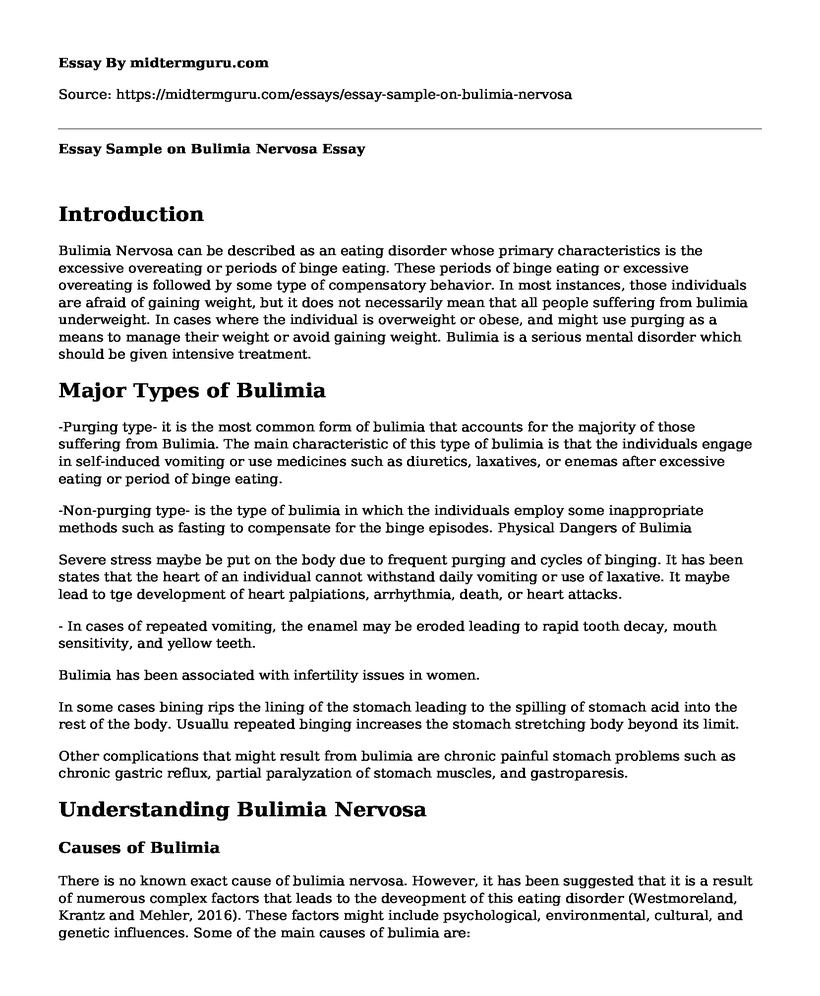Introduction
Bulimia Nervosa can be described as an eating disorder whose primary characteristics is the excessive overeating or periods of binge eating. These periods of binge eating or excessive overeating is followed by some type of compensatory behavior. In most instances, those individuals are afraid of gaining weight, but it does not necessarily mean that all people suffering from bulimia underweight. In cases where the individual is overweight or obese, and might use purging as a means to manage their weight or avoid gaining weight. Bulimia is a serious mental disorder which should be given intensive treatment.
Major Types of Bulimia
-Purging type- it is the most common form of bulimia that accounts for the majority of those suffering from Bulimia. The main characteristic of this type of bulimia is that the individuals engage in self-induced vomiting or use medicines such as diuretics, laxatives, or enemas after excessive eating or period of binge eating.
-Non-purging type- is the type of bulimia in which the individuals employ some inappropriate methods such as fasting to compensate for the binge episodes. Physical Dangers of Bulimia
Severe stress maybe be put on the body due to frequent purging and cycles of binging. It has been states that the heart of an individual cannot withstand daily vomiting or use of laxative. It maybe lead to tge development of heart palpiations, arrhythmia, death, or heart attacks.
- In cases of repeated vomiting, the enamel may be eroded leading to rapid tooth decay, mouth sensitivity, and yellow teeth.
Bulimia has been associated with infertility issues in women.
In some cases bining rips the lining of the stomach leading to the spilling of stomach acid into the rest of the body. Usuallu repeated binging increases the stomach stretching body beyond its limit.
Other complications that might result from bulimia are chronic painful stomach problems such as chronic gastric reflux, partial paralyzation of stomach muscles, and gastroparesis.
Understanding Bulimia Nervosa
Causes of Bulimia
There is no known exact cause of bulimia nervosa. However, it has been suggested that it is a result of numerous complex factors that leads to the deveopment of this eating disorder (Westmoreland, Krantz and Mehler, 2016). These factors might include psychological, environmental, cultural, and genetic influences. Some of the main causes of bulimia are:
- Negative body image
- History of abuse or trauma
- Professional or activities that focus on performance or appearance
- Stressful life changes
Poor Self-Esteem Signs and Symptoms of Bulimia
The signs and symptoms of bulimia include:
- An individual becomes obsessed with the body weight and shape.
- Living in the fear of gaining weight
- The individual exercising or forcing to vomit in attempt to stop from gaining weight after bingeing
- Using diuretics, laxatives, or enema after eating when they are not needed
- Repeated episodes of abnormal eating large quantities of food in a single sitting (Poulsen, 2014).
- Using dietary supplements or herbal products in attempt to lose weight.
- Fasting, avoiding specific foods between binges, or restricting calories.
References
Poulsen, S., Lunn, S., Daniel, S. I., Folke, S., Mathiesen, B. B., Katznelson, H., & Fairburn, C. G. (2014). A randomized controlled trial of psychoanalytic psychotherapy or cognitive-behavioral therapy for bulimia nervosa. FOCUS, 12(4), 450-458.
Westmoreland, P., Krantz, M. J., &Mehler, P. S. (2016). Medical complications of anorexia nervosa and bulimia. The American journal of medicine, 129(1), 30-37.
Treatment of Bulimia
Discontinuing the binge-purge cycle. It is the most essential step that should involve breaking the harmful cycle leading to restoration of healthy eating behaviors. This is the first phase in the treatment process.
The second phase of bulimia treatment involves improving of negative thoughts. It aims to recognize and change the existing irrational beliefs about dieting, weight, and body shape.
The final phase is restoration of emotional issue that result from the eating disorder. The treatment used can aim to address interpersonal relations as well as use cognitive behavior therapy.
Cite this page
Essay Sample on Bulimia Nervosa. (2022, Nov 05). Retrieved from https://midtermguru.com/essays/essay-sample-on-bulimia-nervosa
If you are the original author of this essay and no longer wish to have it published on the midtermguru.com website, please click below to request its removal:
- Impact of Training on Officer Stress
- Essay Example: Carlos Problem Which Is Anger
- Essay on Durer Albrechts Self Portrait at 26
- Inspiration from The Past - Essay Sample
- Why People Abuse Drugs and Effects to Their Mental Well-Being - Paper Example
- Critical Essay on The Global Grapevine: Why Rumors of Terrorism, Immigration, and Trade Matter
- Suicide: A Rising Killer in the Modern World - Research Paper







